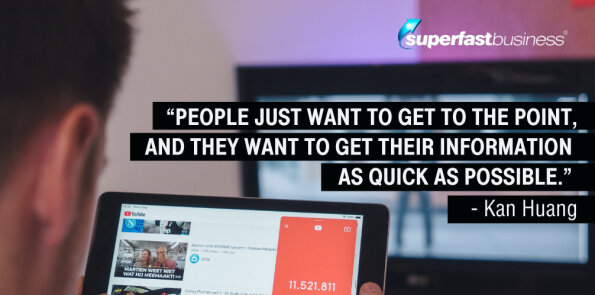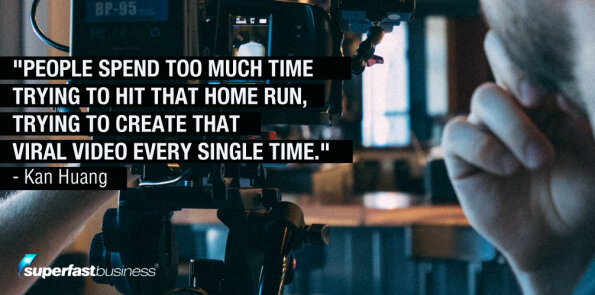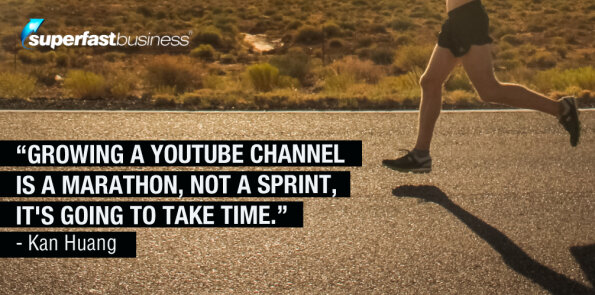Podcast: Download (Duration: 43:51 — 40.2MB)
Get Notified Of Future Episodes Apple Podcasts | Spotify | Amazon Music | Android | Blubrry | Gaana | TuneIn | Deezer | Anghami | RSS | More
In this episode:
Are you putting off recording because you haven’t got the gear? [02:40]
How you appear on camera can make you stand out or lose impact. Get good in front of the lens. [04:02]
Who is your ideal customer audience, and what problem do you solve? Let these inform your video ideas. [08:44]
Teach people stuff, but make it entertaining. [09:47]
Media companies consider what people enjoy – adopt that thinking. [12:44]
What are vanity metrics, and what numbers really count? [17:07]
How do you create more content with less effort? [21:16]
Perfection is not the goal – focus first on quantity. [24:23]
The things you’re kind of good at can add up to something powerful. [27:53]
Enjoy the journey, and before you know it, you’ve reached the destination. [30:22]
You have to start in order to get anywhere – so why not now? [33:38]
If you could do only three things, these are what Kan suggests…. [37:56]
Build better business strategy with help from James
There’s a lot of talk lately about YouTube, with good reason. Second only to Google in visits, the site has more than one billion monthly users. Yet it’s a marketing channel that many business owners are just starting to explore.
Social Wave’s Kan Huang knows from his work with clients that YouTube videos have huge potential for generating revenue. That’s why James has brought him back to offer some tips – 12, to be exact, on growing a YouTube channel and bringing in income for your business.
1 – How much does the gear matter?
He starts with his most commonly received question: What gear should you buy? And his argument is, it doesn’t matter at the beginning.
As far as podcast equipment for beginners goes, an iPhone these days will get you at least 4K quality video, says James. And the microphone with that, even, is good enough for a start. So don’t let gear hold you back. Imagine what you could lose in the time you’re not creating content, all because you’re waiting to afford equipment.
2 – Get good at presenting
Competition is getting fierce, says Kan. So unless you’re a really good presenter, that’s something you need to work on. Focus on the reps. Learn and improve.
And don’t be a copycat. Find your own unique style and flavor.
What are some tips on delivery, asks James?
Energy levels, for one, Kan says. They need to be much higher on camera. The level at which we normally interact can come off quite weak on cam.
Then a lot is in the preparation. Are you more comfortable with a teleprompter, or a list of notes?
It also helps to tackle topics within your area of expertise – if you know a lot about something, it’s much easier to discuss on camera as opposed to moving into something new.
The reps are important, says Kan. You’ve got to get the practice in place. Even the most famous YouTubers had terrible first videos, but they stayed the course and got better.
James has noticed, with YouTube edits, a lot of them seem to clip between sentences. He imagines the person on screen is reading, or having multiple attempts and then editing them together.
 Jump cuts, says Kan, feel almost a little unnatural, but it’s gotten to a stage now where it’s actually a normal thing. He thinks the shorter average attention span may have something to do with it. People just want to get to the point, and they want to get their information as quickly as possible.
Jump cuts, says Kan, feel almost a little unnatural, but it’s gotten to a stage now where it’s actually a normal thing. He thinks the shorter average attention span may have something to do with it. People just want to get to the point, and they want to get their information as quickly as possible.
3 – Who are you serving?
Tip number three is, get clear on who you serve. This is not advice for YouTube alone. In business in general, you have to think about, who is your ideal customer audience, and what problem do you solve?
And you need to feed a starving crowd. Is there demand or a want for the content you’re creating? Do people love it? Only then will you see success on YouTube.
4 – Create edutainment
Tip number four is you need to create content that’s both entertaining and helpful. If you’ve ever heard an academic deliver a lengthy, bone-dry rehash of their research, you know their talk could benefit from a shot of entertainment. Then on the other hand, there’s most TikTok videos, big on fun and short on anything remotely helpful.
Some of the best YouTubers talk about things people enjoy hearing about, and learn from at the same time.
5 – Do like the media companies
Number five is to treat yourself like a media company. If Netflix were to create content about how awesome they were, no one would watch. Unfortunately, many business owners on YouTube do just that – everything they put out is a sales pitch.
Think about what people enjoy. What content can you create, within your area of expertise, that they will come back for? Where you do that, you build an affinity with your channel and your brand. Then people want to find out what you do and what problem you solve, leading to inquiries for your products and services.
James likes the media business label. It’s probably why most of his and Kan’s clients are succeeding, and it fits very nicely into the OwnTheRacecourse philosophy of controlling your content.
6 – The numbers aren’t the be all and end all
Tip number six: don’t focus on the numbers. Most people can’t help but obsess about subscribers and likes. But the reason you shouldn’t is, growing a YouTube channel is a marathon, not a sprint. It’s going to take time.
“You don’t need massive numbers to drive massive revenue growth.”
And unless you’re monetizing your channel, and want to be an influencer and make money through AdSense and the like, you don’t actually need massive numbers to drive significant revenue growth.
One of Kan’s clients gets 4,000 subscribers and about 15,000 unique views every single month. But what that translates into is 120 to 150 leads every single month, which he converts at about 50 to 60 percent. Each client is worth about $3,000 to $5,000 each. Not bad for a channel with only 4000 subscribers a month.
So what should we be focused on? What’s pipelined and what ends up coming through in terms of revenue. Leads.
7 – There are easier ways of putting out content
The next tip is, make it easy for yourself to be prolific. How do you make it easy to create content? Do you do it on your morning commute? Or do you invest half a day to knock out six or seven videos? Determine when you have the most energy and work around that.
The smartest people on YouTube find the batch method easiest. It means you set up and prime yourself once, and get multiple videos for your effort. And another good thing about it is you can bank your content, so that when publishing time comes you have it all ready to put out.
“Environment setup is critical.”
James loves it. Environment setup is critical, too, he says. He’s got his own recording space set up – camera, lights, microphone, computer – so that he can walk in, press a button, and record. And he’s well ahead of schedule with the recordings currently in his bank.
8 – Do the reps before worrying about quality
This is probably one of the most important, if not the most important tips, says Kan, and that is focus on quantity first before quality. So do the reps.
“Perfection is the enemy of good.”
Perfection is the enemy of good. Even if it’s not good enough, if you’re not a hundred percent happy with it, just publish the content. You’re not trying to hit a home run every single time.
Growing a YouTube channel is like investing. You want to be diversified; you need to have a lot of videos, at least initially, that don’t do great. Some of them will do okay, but a small percentage will go viral, and lift the success of the channel. You’re essentially trying to manufacture a bit of luck.
 People spend too much time trying to hit that home run, trying to create that viral video every single time. And when it’s not good enough, they end up not publishing. And when they don’t publish, they’re not consistent. So Kan says, focus on the reps, and the rest will take care of itself.
People spend too much time trying to hit that home run, trying to create that viral video every single time. And when it’s not good enough, they end up not publishing. And when they don’t publish, they’re not consistent. So Kan says, focus on the reps, and the rest will take care of itself.
9 – What is your edge?
Tip number nine is about understanding and using your competitive advantage. The best example of this, says Kan, is Dilbert creator Scott Adams. Adams is a smart guy who explains his success by saying, Every time you acquire a new skill, and you get quite good at it, you double your odds of success.
Adams is an okay artist. He writes okay, too, and he’s a bit funny. Nothing outstanding. But put that all together and you’ve got Dilbert, one of the most celebrated comic strips on the planet.
Polymaths like Scott Adams pull from various different areas to solve problems. They have some expertise across two or more different subjects. They can connect dots across different fields and come up with solutions that usually can’t be reached by an expert in just one specific area. They see the big picture in a lot of ways.
So understand, says Kan, you don’t need to be at the top of your game before launching a YouTube channel. You just need to identify the two or three things that you’re pretty decent at, that you’re better than most people at, and combine them to create your competitive advantage.
10 – It’s the trip, not the destination
Enjoy the process more than the end goal. A lot of people are focused on reaching a million subscribers, or whatever the vanity number is. But it’s not about the goal, it’s about the process of the journey.
“Enjoy the process more than the end goal.”
If you enjoy creating, making videos, and you enjoy sharing your content through your channel, that is actually a huge contribution to your success. Because if you like what you’re doing, you’ll continue to do it for the long haul that’s required to get results.
11 – What are you waiting for?
Number 11 is, just start. As Kan said, you’re doing the reps, not aiming for perfection. So just get your first batch of content out there. All of Kan’s clients cringe at their first videos. They’re not great. But they got them out of the way and kept on, and got better over time.
 The first milestone of success is always the hardest, like making your first $10,000 is much harder than making your first million dollars. But once you get a roll on and things start snowballing, it gets easier.
The first milestone of success is always the hardest, like making your first $10,000 is much harder than making your first million dollars. But once you get a roll on and things start snowballing, it gets easier.
And YouTube is a search engine. There’s a compounding effect of publishing videos on a regular basis. You don’t make your money in the first video, but at the tail end. So just start.
12 – The top three things you need to do
Rounding it out is tip number 12. It’s a kind of summary or takeaways based on the first 11 items. And it is, if you were to do just three things, that would be:
The majority of people will find the above prescription too hard. But remember, when things have a higher barrier of entry, that’s usually when you get the best results. Ultimately, it’s about who can stay in the race the longest.
Now, there are things people may want to know that weren’t on the list – tactical aspects like tags, titles, thumbnails, pre-rolls. Is any of that important, asks James?
It is important, says Kan, worth doing a separate episode.
Until then, if you have a YouTube channel, or have yet to start one and want help, or if you’d like an assist with your marketing, you can reach Kan at [email protected]. Or drop by his website, socialwave.com.au, and fill in an inquiry form. Kan can jump on a call with you, and find out where you’re coming from and if he can help.
Access a wealth of business resources inside JamesSchramko membership
Liked the show? Leave us a review on iTunes










Leave a Reply